| | | |
Archive
| « December 2025 » |
|---|
| Mo | Tu | We | Th | Fr | Sa | Su |
|---|
| 1 | 2 | 3 | 4 | 5 | 6 | 7 | | 8 | 9 | 10 | 11 | 12 | 13 | 14 | | 15 | 16 | 17 | 18 | 19 | 20 | 21 | | 22 | 23 | 24 | 25 | 26 | 27 | 28 | | 29 | 30 | 31 | |
|
| | | |
|
|
|
|
|
|
|
8 November 2009 | Views: 3644 | Comments: 0 |
|
|
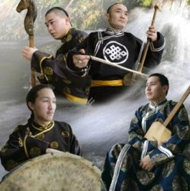 In Ulan-Ude, Buryatia, the 4th International Festival-contest of throat-singing, “The Breath of the Earth” just took place. In Ulan-Ude, Buryatia, the 4th International Festival-contest of throat-singing, “The Breath of the Earth” just took place.
Throat singers from Khakassia, Tuva, Altai, Khabarovsk and Trans-Baikal regions, Irkutsk region, Buryatia, and Mongolia participated in the contest.
Diplomas of th 1st order were received by Yevgenii Ulugbashev (Khakassia), and the Tuvan folklore group “Arzhaan” (Tuva, leader Opuyla Artysh), as the information portal “Baikal24” announced.
|
|
|
|
|
|
Baikal24, translated by Heda Jindrak |
|
|
|
|
|
|
|
|
7 November 2009 | Views: 4263 | Comments: 0 |
|
|
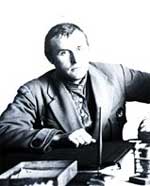 In Tuva, Sergei Kuzmich Kochetov is a legendary personality. The village where he spent his youth and one of the central streets in Kyzyl bear his name. He was a participant in three wars – The World War I, the Civil War, and the Great Patriotic War. He fought at Moscow, battled at Kursk, liberated Kiev. When he returned to Kyzyl, he became the first delegate to the Supreme Soviet of USSR from the republic. Sergei Kochetov was born on November 7, 1894 in the Kodybai village of Minusinsk district. In Tuva, Sergei Kuzmich Kochetov is a legendary personality. The village where he spent his youth and one of the central streets in Kyzyl bear his name. He was a participant in three wars – The World War I, the Civil War, and the Great Patriotic War. He fought at Moscow, battled at Kursk, liberated Kiev. When he returned to Kyzyl, he became the first delegate to the Supreme Soviet of USSR from the republic. Sergei Kochetov was born on November 7, 1894 in the Kodybai village of Minusinsk district.
|
|
|
|
|
|
Dina Oyun, translated by Heda Jindrak |
|
|
|
|
|
|
|
|
6 November 2009 | Views: 3761 | Comments: 0 |
|
|
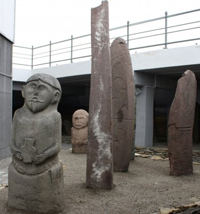 The ancient stone images that were brought to the National Museum of Tuva over the years from different corners of the republic are now on view by all those who wish to see them. In the stelarium of the museum, which is located on the ground floor, fifty-five stone figures are exhibited in chronologic order, starting with the Bronze Age to the Mongol period of Tuva. These are stones with images of animals, masks-faces, reindeer stones, stelae with ancient Turkic runic writing, stone human figures (kizhi-kozhee). There are also reference materials, archeological map of Tuva, materials on the Uighur fortress Por-Bazhyn, and on towns of the Mongol period of Tuva. The ancient stone images that were brought to the National Museum of Tuva over the years from different corners of the republic are now on view by all those who wish to see them. In the stelarium of the museum, which is located on the ground floor, fifty-five stone figures are exhibited in chronologic order, starting with the Bronze Age to the Mongol period of Tuva. These are stones with images of animals, masks-faces, reindeer stones, stelae with ancient Turkic runic writing, stone human figures (kizhi-kozhee). There are also reference materials, archeological map of Tuva, materials on the Uighur fortress Por-Bazhyn, and on towns of the Mongol period of Tuva.
|
|
|
|
|
|
museumrt.ru, translated by Heda Jindrak |
|
|
|
|
|
|
|
|
2 November 2009 | Views: 3909 | Comments: 0 |
|
|
 The Tuvan ethno-group “Huun-Huur-Tu”, and Tuvan-Austrian singer Sainkho continue with their joint concert experiments on the stage of Hong Kong, after which tehey are expected in Oslo, Norway. The tandem of the two famous projects was introduced on October 11 in Russia, in the Moscow House of Music, on the day of the 65th Anniversary of Tuva’s entering the system of Soviet Union. The Tuvan ethno-group “Huun-Huur-Tu”, and Tuvan-Austrian singer Sainkho continue with their joint concert experiments on the stage of Hong Kong, after which tehey are expected in Oslo, Norway. The tandem of the two famous projects was introduced on October 11 in Russia, in the Moscow House of Music, on the day of the 65th Anniversary of Tuva’s entering the system of Soviet Union.
|
|
|
|
|
|
Dina Oyun, translated by Heda Jindrak |
|
|
|
|
|
|
|
|
1 November 2009 | Views: 4214 | Comments: 0 |
|
|
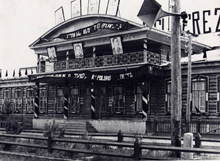 A meeting dedicated to the victims of political repressions was held by the Monument of the Undefeated Arat in the capital of Tuva on October 30. 10-20 meters from the monument, there is a one-story grey wooden building, which today contains a museum of political repressions. Its history is closely related to this tragic page in the history of Tuva. In the basement of this house, by the burning-hot stove, confessions were extracted from the accused. A meeting dedicated to the victims of political repressions was held by the Monument of the Undefeated Arat in the capital of Tuva on October 30. 10-20 meters from the monument, there is a one-story grey wooden building, which today contains a museum of political repressions. Its history is closely related to this tragic page in the history of Tuva. In the basement of this house, by the burning-hot stove, confessions were extracted from the accused.
|
|
|
|
|
|
Dina Oyun, translated by Heda Jindrak |
|
|
|
|
|
|
|
|
31 October 2009 | Views: 4125 | Comments: 0 |
|
|
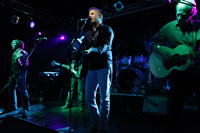 Everyone in Europe and in almost all other parts of the world knows Kevin Costner, one of the few American top movie stars who is known to be interested not only in the American way of life but is equally attracted to foreign cultures and peoples. He had proven this in producing in 1994 an ethnologically valuable documentary about Rapa-Nui, a small volcanic island in the southern Pacific Ocean and the most eastern Polynesian settlement, which had been annexed by Chile in 1888 and named Isla de Pascua, Easter Island. Famous for its “moais”, monumental statues of volcanic rock and other natural materials depicting humans, such as the most famous seven of them called Ahu Akivi. Rapa-Nui is also famous for its unique hieroglyphic letters, in part deciphered by German ethnologist Thomas Barthel. Everyone in Europe and in almost all other parts of the world knows Kevin Costner, one of the few American top movie stars who is known to be interested not only in the American way of life but is equally attracted to foreign cultures and peoples. He had proven this in producing in 1994 an ethnologically valuable documentary about Rapa-Nui, a small volcanic island in the southern Pacific Ocean and the most eastern Polynesian settlement, which had been annexed by Chile in 1888 and named Isla de Pascua, Easter Island. Famous for its “moais”, monumental statues of volcanic rock and other natural materials depicting humans, such as the most famous seven of them called Ahu Akivi. Rapa-Nui is also famous for its unique hieroglyphic letters, in part deciphered by German ethnologist Thomas Barthel.
|
|
|
|
|
|
Jügen Boden, Germany, Photo by Polodrome (Jüchen) |
|
|
|
|
|
|
|
|
26 October 2009 | Views: 3352 | Comments: 0 |
|
|
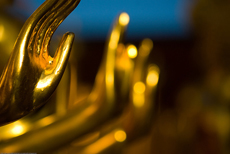 An airplane arrived with the most eagerly awaited cargo – 1000 goldedn Buddha statuettes – destined for the “Ustuu-Khuree” temple, the opening of which is planned fro the spring of next year. The priests of the administration of the Kamby-Lama of Republic Tuva carried out the active collecting of the means in the districts. An airplane arrived with the most eagerly awaited cargo – 1000 goldedn Buddha statuettes – destined for the “Ustuu-Khuree” temple, the opening of which is planned fro the spring of next year. The priests of the administration of the Kamby-Lama of Republic Tuva carried out the active collecting of the means in the districts.
|
|
|
|
|
|
savetibet.ru, translated by Heda Jindrak |
|
|
|
|
|
|
|
|
25 October 2009 | Views: 3182 | Comments: 0 |
|
|
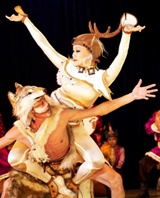 Tuvan state ensemble of song and dance “Sayany” introduced their new concert program, “In the Cradle of Sayans and Tandy”, to the Kyzyl audience. The program was prepared for the occasion of the 40th anniversary of the team. Tuvan state ensemble of song and dance “Sayany” introduced their new concert program, “In the Cradle of Sayans and Tandy”, to the Kyzyl audience. The program was prepared for the occasion of the 40th anniversary of the team.
The premiere of the program is being presented during these days in the Tuvan State philharmony. Experts from Mongolia and Tuva participated in the preparation of the production.
|
|
|
|
|
|
Kheimer-ool Oorzhak, translated by Heda Jindrak, photo Sergei Kulik |
|
|
|
|
|
|
|
|
24 October 2009 | Views: 3039 | Comments: 0 |
|
|
A short movie “Citizen of the World”, made by 17-year-old Denis Yadykin, a student of Kyzyl Roads and Transportation institute,
 was selected into a special program of the XIV Internationa festival of Ecological Films “Green Vision-2009”. An official announcement was sent from the organizing committee to the address of the director of the “Dersu Uzala” foundation, Svetlana Munzuk. was selected into a special program of the XIV Internationa festival of Ecological Films “Green Vision-2009”. An official announcement was sent from the organizing committee to the address of the director of the “Dersu Uzala” foundation, Svetlana Munzuk.
|
|
|
|
|
|
Dina Oyun, translated by Heda Jindrak |
|
|
|
|
|
|
|
|
24 October 2009 | Views: 4536 | Comments: 0 |
|
|
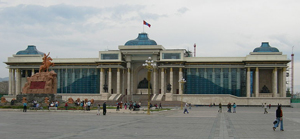 At the end of October, the Premier of Tuvam sholban Kara-ool will meet with the president of Mongolia, Tsakhiagiyn Elbegdorj. The head of the border region of Russia received an official invitation to visit Ulan-Bator from the new government of Mongolia in June of theis year. At the end of October, the Premier of Tuvam sholban Kara-ool will meet with the president of Mongolia, Tsakhiagiyn Elbegdorj. The head of the border region of Russia received an official invitation to visit Ulan-Bator from the new government of Mongolia in June of theis year.
Tuva, there fore , plans to re-establish once-close economic and cultural ties with their neighbors, which were interrupted during the “perestroika” years.
|
|
|
|
|
|
Dina Oyun, translated by Heda Jindrak |
|
|
|
|
|
|
